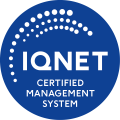How we work
Our activity is structured in steps, so that we can follow a linearity that is very effective. In fact, starting from the meeting with the customer to get to the electronic designs, ending with the distribution of the product, we want to ensure full satisfaction with our work. We develop design, mechanical, electronic and software solutions, using continuously updated technologies.
All processes are developed according to our ISO 9001:2015 certified quality management system.

Here are the 7 steps:
- Meeting
- Electronic design
- Mechanical design
- Prototyping
- Testing
- Production
- Distribution
Meeting
We believe it is essential to be able to interface with our customers, in order to understand together how to structure an activity in a way that achieves the target of their set objectives. It is fundamental to develop a synergy between the various sectors dedicated to electronic design, production, testing and distribution. It is also essential to maintaining a constant and continuous relationship with the customer. As a solid yet versatile company we do everything in our power to fulfill every request of our customers, whether they may be a single user or a large company. We do so thanks to our focus on creating complete and fully customizable products.
To ensure the achievement of the quality and reliability objectives of the product, we analyze all aspects of the project, so that we can effectively apply advanced analysis techniques study the engineering of the process.
Electronic design and software development
Since 1988 the company has been carrying out many activities including: research and development, conception and technological innovation, as well as electronic design and production of in-house hardware and software. In addition, it produced a vast range with electronic controls for electric heating, household appliances, industrial and electromedical equipmentAll Selmo products are designed in accordance with the CE mark. The entire cycle, from electronic design to the production of electronic systems, is performed and managed with the company’s own resources, independently or in collaboration with the customer for the Original Equipment Manufacturer (OEM) services. Even when the customer submits his own finished product to the certification process by the regulating bodies, Selmo supports the certification by providing the authorities with all the information within its scope of competence. The electronic design starts from a specification decided by the customer, which is analysed by Selmo through a preliminary feasibility study of the project in question. Subsequently, the actual electronic hardware and software design takes place through the use of prototypes made by our research and development department in the Selmo laboratories. This is performed in order to obtain pre-compliance with the CE standards. These prototypes are subsequently shared with the customer for approval. With our support, the customer can then proceed to perform electrical safety and electromagnetic compatibility (EMC) tests at accredited laboratories and external bodies to obtain the CE certification (and others if required by the project) from the accredited bodies. .
Mechanical design
Prototyping
Compliance test CE

Selmo produces NF Electricite and NF Performance certifiable products
Production
QUALITY IN PRODUCTION
In order to guarantee that the product will achieve the objectives of quality and reliability, we analyze all aspects of the project to effectively apply the techniques of advanced analysis and study of the engineering process. The achievement of the quality standard in the production phase is also possible thanks to the collaboration with a network of certified suppliers and the traceability system that follows the product.
PRODUCTION LINE
The production of electronic boards containing SMT (Surface-mount technology) components is carried out in an automated line and its phases are marked as follows:
• Automatic screen printing for the positioning of the weld paste and 2D optical control for the verification of its correct application;
• Automatic positioning of components with ‘Pick and Place’ machine;
• Welding of components with reflow furnace.
The board passes from one machine to another thanks to a conveyor belt. If requested by the customer, it is possible to request that tests and inspections of the board be carried out. If the board does not include traditional components (PTH – Through-hole technology), at the end of this phase we proceed with the possible assembly of the plastic parts. If PTH components are planned, the following are added to the phases described above:
• Automatic or manual positioning of PTH components;
• Wave welding;
• Visual controls;
• Functional testing.
The production ends with the possible assembly of the plastic parts and packaging. At the end of the production phases, logistics will take care of the delivery of the products.
Distribution
The distribution phases are planned and agreed jointly with our customers based on the types of product and the production site chosen. This is done in order to ensure the best process synergies and avoid unnecessary and costly movement of products.
In addition to providing high-level electronic and mechanical designs, we also manage the entire prototyping and production. As a consequence we are also able to offer a high degree of flexibility for worldwide distribution, by also taking into account the specific design needs of the project.

© Selmo. All rights reserved.